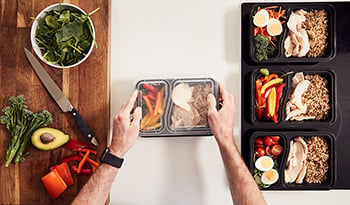5 Steps for Building the Perfect Smoothie According to a Dietician

Looking for a low-prep, nutritious meal or snack? (Who isn’t!) Look no further than the infinitely versatile smoothie.
I love smoothies partly because they are easy to tailor to individual preferences. Smoothies are endlessly customizable, from fruits and veggies to protein add-ins, to health “boosts,” and various ways to incorporate healthy fats. And there is no better way to replenish after a workout or refresh on a hot day than a chilled smoothie.
While smoothies can be packed with essential vitamins, minerals, antioxidants, and other nutrients, not all smoothies are created equal. Pre-made packaged smoothies and those sold at smoothie stores often use fruit juice as a base and contain added sugar. The natural sugar found in fruit is no cause for concern for most people, but added sugar detracts from the healthfulness of a smoothie.
Often, the most nutritious smoothie is one you make yourself. Here are the key steps, components, and tips for building a healthy, balanced, and delicious smoothie!
1. Choose Your Base
There are countless ways to make your unique smoothie, but all start with a base that makes up the bulk of your drink. Most smoothies use fruits, veggies, or some combination of the two as their base. If you’re following a lower-carb diet, vegetable-based smoothies can be made without fruit. Otherwise, fruit adds a natural sweetness and more volume for a satisfying smoothie.
Fresh or Frozen?
Fresh and frozen fruit both work well as a smoothie base. When using fresh fruit, include ice in your blender to chill your drink as it blends. If using frozen fruit, you don’t need to add ice—the defrosting fruit will make for a cold, refreshing smoothie.
Flavorsome Fruits
All fruit provides carbohydrates, fiber, and a variety of vitamins and minerals. Berries are a popular smoothie addition because they pack antioxidants that may help protect your cells from free radical damage, and their tiny seeds add a nice texture to a smoothie.1
Bananas and tropical fruit like pineapple, mango, and kiwi are also excellent for smoothies. Watermelon, cantaloupe, and honeydew are also good options for smoothies, but because their water content is high, they give smoothies a thinner consistency.
No fruit is off-limits, so choose the combination that appeals most to you!
Load up on Veggies
Vegetables should be part of your smoothie base, too. While veggies are often enjoyed as a part of savory meals and dishes, adding them to a smoothie is a great way to boost nutrients and sneak in a hearty serving for someone who doesn’t eat many vegetables otherwise.
Leafy greens, like kale and spinach, are popular additions to smoothies and are easily disguised once combined with the natural sweetness of the fruit. Other vegetables you may consider adding to your smoothie include beets, celery, cucumber, and carrots.
In most cases, veggies change the color of a smoothie without significantly changing the flavor—so you can create some really beautiful smoothies while boosting their nutritional value. Start with a small portion and slowly add more to reach your preferred flavor and hue when in doubt.
Veggie Powders
Veggie powders can be a great option when you are running low on fresh veggies or prefer not to incorporate them into your smoothie. For example, while beets are packed with nutrients, not everyone is a fan of their flavor.
Beet powders are easy to keep on hand and simple to add to your water before a workout or your breakfast smoothie. A little beet powder in your smoothie ups the fiber and antioxidant content and adds a natural source of nitric oxide that may benefit your circulatory system.2
You could also try one of the wide variety of green powders that can be used in place of, or in addition to, veggies in your smoothie. Many of these products pack a nutritious punch with large amounts of dark leafy greens, like kale and wheat grass, alongside other plant-based ingredients, like spirulina.
These dark green leafy vegetables are a great source of vitamin K—a nutrient essential for blood and bone health that is not as abundant in other foods.3 This is the perfect solution for someone who wants to load their smoothies with nutrients but isn’t a fan of vegetables!
2. Pick a Protein
While smoothies can be an excellent source of essential nutrients, it takes diligence to build a well-rounded drink. While your smoothie base of fruits and vegetables is an excellent source of carbohydrates and other nutrients, like fiber and antioxidants, it provides very little fat and protein.
To make a smoothie a balanced meal, it should contain carbs, fat, and protein, along with fruits and veggies. The fruit in your smoothie provides most of the carbohydrates in your drink, so let’s explore ways to add some protein.
Protein and Collagen Powders
Protein powders are a popular, convenient way to add protein to your smoothie. Because they come in a wide variety—like whey, soy, pea, and brown rice proteins—there is indeed a protein powder for everyone. No matter your dietary restrictions, you can find a protein powder on the market to suit your needs.
While protein powders make a great addition to a smoothie, they can easily be enjoyed in a simple glass of water for workout recovery, and you can even cook and bake with them. Keep a container of protein powder on hand at home for an easy addition to many meals and snacks. As an alternative, collagen powder also provides protein and can be used in addition to, or in place of, protein powder in your smoothie.
Greek Yogurt
Greek yogurt is another great option for adding protein to your smoothie. Greek yogurt contains about double the amount of protein as regular yogurt—around 17 grams compared with 9 grams per serving.
Unflavored with zero added sugar is best. And even if you don’t like the natural bitterness of plain yogurt, it is easily disguised behind all the fruit in your smoothie.
Additionally, you can add protein through the liquid you choose, and many of the fats you may include in your smoothie can also contribute protein. More on this later!
3. Fats Are an Essential Nutrient
Fat is an essential nutrient that increases satiety following a meal and helps your body absorb fat-soluble vitamins. Nuts, seeds, and nut butters are excellent additions to a smoothie as they provide a unique flavor along with healthy fats and protein.
Ground flax seeds or flax meal, chia seeds, and hemp seeds, in particular, all provide anti-inflammatory omega-3 fatty acids, a nutrient not commonly found in plant-based foods, and protein.4 Like seeds, nuts also provide protein, fiber, and healthy fats. Whole nuts, like walnuts, pecans, and macadamia nuts, blend nicely into a smoothie, but you can also use nut butter to add healthy fats to your drink.
4. Add a Boost
With all the fruits, veggies, protein, and healthy fats, you’ve already created a nutrient-packed drink—but these additions can make your smoothie even more of a nutrient powerhouse:
- Bee pollen: Granules of bee pollen blend easily into a smoothie without affecting its flavor, helping to support your immune system and liver health.5
- Cocoa nibs: Antioxidant-rich cocoa nibs lend a light chocolatey flavor to your smoothie while helping combat damage from free radicals.
- Spirulina: This blue-green algae may support healthy cholesterol levels and blood pressure and help manage blood sugar in people with type 2 diabetes.6 Spirulina is frequently included in green powders, but you can add it separately to your smoothie.
5. Choose Your Liquid
Now that you’ve incorporated all the solid ingredients into your smoothie, it’s time to add your liquid of choice and blend it up! Your liquid serves one main purpose—to emulsify and bring together your dry ingredients. While water can get the job done, there are plenty of other liquids to consider that add additional nutrients and flavor while bringing together your drink.
Milk is one option, and within this category, there are many varieties. Some available types are dairy, nut-based, soy, hemp, rice, and oat milk. Which is best for your smoothie comes down to your personal preference and dietary needs.
Keep an eye on grams of added sugar when choosing your liquid. Some flavored milks and milk substitutes have sugar added to them. It’s always best to rely on the sweetness of the fruit in your smoothie over added sugar.
Also, consider including coconut water, green tea, or coffee, depending on the flavor and caffeine level you are going for in your smoothie.
Get Creative
Building your smoothie can be an exercise in creativity and change day-to-day based on your preferences. There are countless variations to try out based on your mood, nutrition needs, and what fruits, veggies, proteins, fats, and liquids you have on hand. You can't go wrong when you have all the necessary components of a balanced smoothie.
Remember these tips when putting together your next smoothie to ensure a balanced, nutrient-packed recipe!
References:
- Lobo V, Patil A, Phatak A, Chandra N. Free radicals, antioxidants and functional foods: Impact on human health. Pharmacognosy Reviews. 2010;4(8):118. doi:10.4103/0973-7847.70902
- Clifford T, Howatson G, West DJ, Stevenson EJ. The Potential Benefits of Red Beetroot Supplementation in Health and Disease. Nutrients. 2015;7(4):2801. doi:10.3390/NU7042801
- Vitamin K - Health Professional Fact Sheet. Accessed August 15, 2022. https://ods.od.nih.gov/factsheets/VitaminK-HealthProfessional/
- Natto ZS, Yaghmoor W, Alshaeri HK, van Dyke TE. Omega-3 Fatty Acids Effects on Inflammatory Biomarkers and Lipid Profiles among Diabetic and Cardiovascular Disease Patients: A Systematic Review and Meta-Analysis. Scientific Reports 2019 9:1. 2019;9(1):1-10. doi:10.1038/s41598-019-54535-x
- Khalifa SAM, Elashal MH, Yosri N, et al. Bee Pollen: Current Status and Therapeutic Potential. Nutrients. 2021;13(6). doi:10.3390/NU13061876
- Lafarga T, Fernández-Sevilla JM, González-López C, Acién-Fernández FG. Spirulina for the food and functional food industries. Food Research International. 2020;137:109356. doi:10.1016/J.FOODRES.2020.109356
DISCLAIMER:This Wellness Hub does not intend to provide diagnosis...













































































 Table of Contents
Table of Contents
















